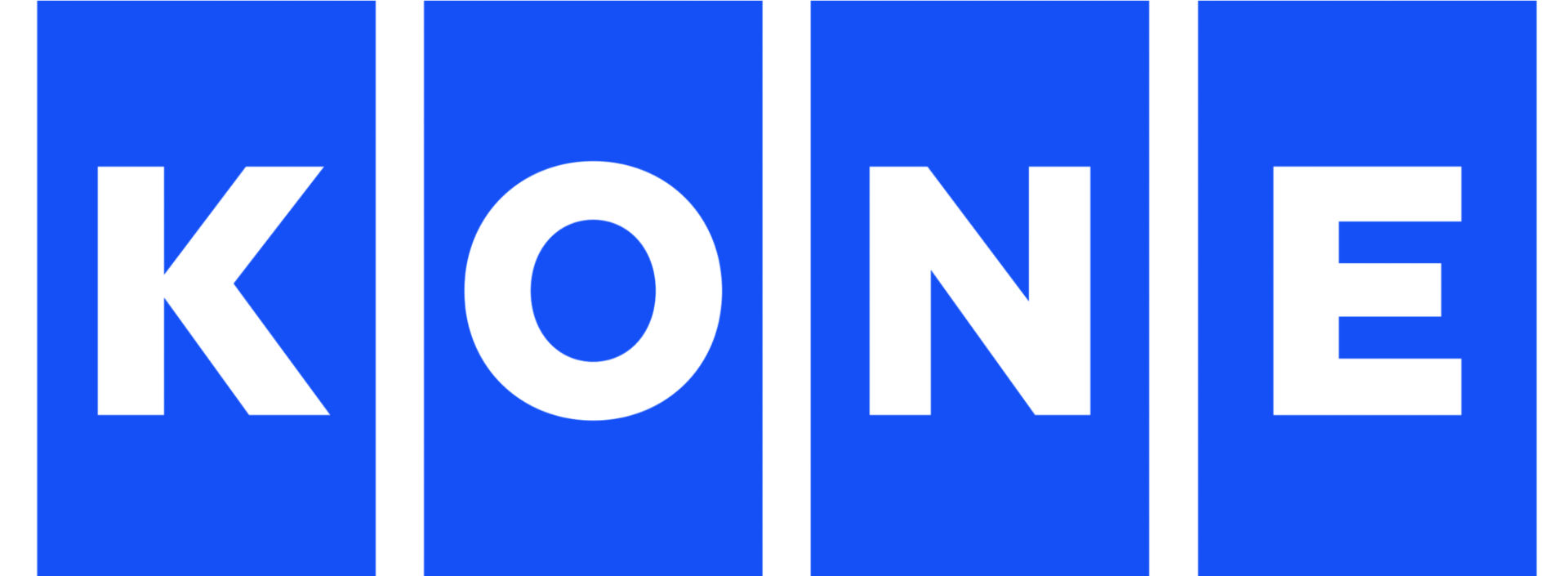Would you like to explore our corporate site or visit your local website?
Stay on Corporate sitePaving the way for smooth collaboration at KONE
How to do Agile Quarterly Planning with more than 1000 colleagues?
Paving the way for smooth collaboration at KONE
During the past couple of years, we have been experimenting with lean and agile ways of doing our quarterly planning with more than 1,000 colleagues. I’m Joonas Alapiha, currently working as Head Agile Coach at Equipment R&D (QRD) in KONE, which is part of KONE Technology and Innovation (KTI). Part of my work is to change the mindset towards more agile and collaborative ways of planning and executing, to enable continuous improvement in our ways of working and collaborating in distributed teams.
Here’s a recap of our quarterly planning journey this far - how it all started with pilot tribes last year over three pilot planning rounds, what we’ve learned, and how we are executing quarterly planning today with more than 1,000 colleagues.

Paving the way for smooth collaboration at KONE
Round 1: The goal for the new way of planning and first planning session in 2021
Initially, the goal of the quarterly planning session was to connect the portfolio and execution levels and align our plans for the next three months. This meant getting about 250 colleagues from our pilot tribes in KONE Equipment R&D (part of KTI) to collaborate across locations and time zones, with numerous stakeholders. Naturally, everything was to be done online due to the global COVID-19 pandemic.
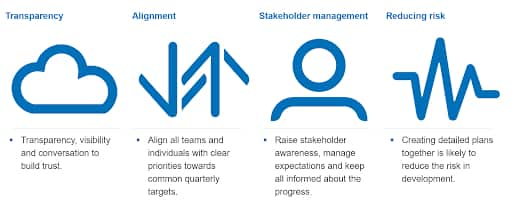
Paving the way for smooth collaboration at KONE

Paving the way for smooth collaboration at KONE
Collaboration is one of KONE’s values. We’re hard-wired to provide the best service to our customers. Whether it is a technical challenge or a matter of bringing our experts in front of a virtual Kanban board – we always collaborate as one team.
Our quarterly planning process experiment had three different phases:
- Pre-planning
- Aligning expectations and roadmaps with business stakeholders
- Aligning expectations and dependencies with other dependent tribes and stakeholders
- Creating and iterating preliminary plans for the quarter
- Planning event (2 days)
- Detailed planning for the quarter within teams and with stakeholders
- Aiming to resolve dependencies and risks through fast decisions
- Post-planning activities
- Updating roadmap
- Retrospective session
After the planning days we held a retrospective session with 30 key participants and gathered their feedback. We concluded our successes and areas of improvement.
The pros:
- The vote of confidence for the outcomes of our sessions gave us a result of 3,5/5 - which can be considered a very good result, this being our very first quarterly planning session using this method.
- Virtual collaboration via Teams and channels worked well, and it was easy to join other teams’ meetings.
- Lots of active discussion. The different teams also invited guests and other stakeholders to solve dependencies and risks.
- Quarterly planning provided transparency, alignment with stakeholders, and a long-term view of our roadmaps.
The cons:
- It became even more clear that this is a marathon, not a sprint. It’s all about a long-term process, not just a one or two-day planning event. This puts emphasis on the pre-planning phase for all participants and in the future, we’ll invest more effort to get the most out of it.
- We found out that it’s fairly easy to organize a quarterly planning process, although it requires lots of preparation and pre-planning activity.
- We should have more detailed schedules and time slots for different stakeholders to manage the flow of meetings and to find the right time to visit each other’s calls to avoid unnecessary interruptions.
- We can make the link stronger between portfolio and execution backlogs.
Quite a good start and clear action points to improve for round two.
Paving the way for smooth collaboration at KONE
Round 2: Eat, sleep, do quarterly planning, repeat – How we improved our collaboration for round two
Based on the retrospective, it was great to hear that the participants felt the planning process provided them with a wider perspective, and we increased cross-team and cross-stakeholder communication. This is a major victory in itself, for a distributed team that operates globally.
For the second round, we implemented multiple changes for a better, more productive quarterly planning process and event. Below I listed our key improvement actions:
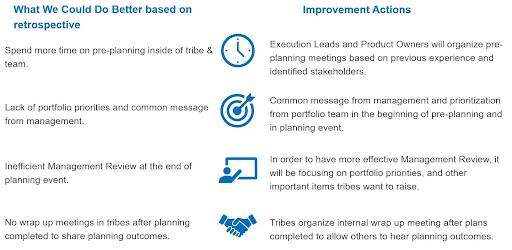
Paving the way for smooth collaboration at KONE
We also introduced the OKR (Objective and Key Results) model to our pilot process. Why OKRs? Because this model helps us to set transparent long-term objectives together that contribute to the bigger mission, and help us visualize the interdependencies between teams. It also boosts an agile mindset and readiness to change without compromising the end objectives.
In practice, each tribe defined at least one OKR for the next quarter. The goal was to help them to familiarize with the model and structure their way of planning. In essence, this is how the O and KR’s are defined:
- Objectives define the goal “Where do we want to go?”
- Key Results set the measurable targets on “How will we know if we are there or not?”
- Initiatives are the actions “What we need to do to achieve the desired results and objectives?”
OKRs differ from KPIs. I listed some of the differentiating factors below:
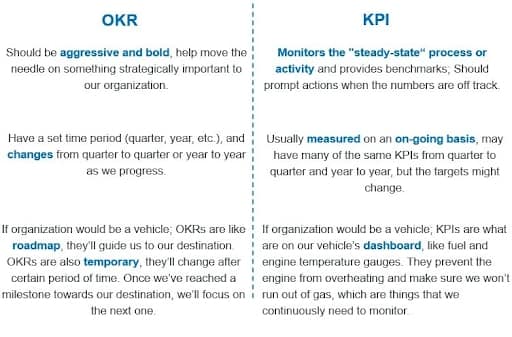
Paving the way for smooth collaboration at KONE
The second quarterly planning saw significant progress compared to the first one. The results were great and I believe we’ve taken big steps forward in adapting to agile and collaborative ways of working and thinking.
Paving the way for smooth collaboration at KONE
Round 3: If you want it, quarterly plan it, work for it – How we organized quarterly planning with more than 1,000 employees in March 2022
In March 2022, we implemented our Quarterly Planning pilot learnings for all tribes and common services in KONE Equipment R&D. This meant involving more than 1,000 team members altogether.
In addition, our quarterly planning days are nowadays also structured around elements from SAFe’s PI Planning. For example:
- Equipment R&D wide kick-off session to provide portfolio-level priorities and leadership messages.
- Draft plan review in the middle of planning days to review already-identified risks and agree mitigation actions.
- All tribes have their own opening and closing sessions where they align their priorities, focus areas and practicalities for planning.
- We close the Quarterly planning days with confidence voting.
This was also the first time that a common backlog tool was used. We all know that transformation is not about tools and practices, but a common tool turned out to be a good addition enabling us to visualize dependencies and provide transparency.
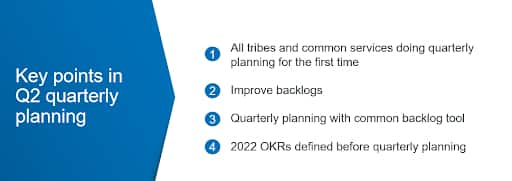
Paving the way for smooth collaboration at KONE
What we learnt from quarterly planning in March 2022
We got lots of positive feedback as now all of Equipment R&D was involved compared to previous rounds when only pilot tribes were doing quarterly planning. Also our virtual collaborating method - common Teams + Channels - worked nicely with wider participation as well, and joining in other teams’ meetings was easy.
The biggest improvement areas are:
- Alignment of the plans across tribes, and alignment between tribes and common services.
- Involvement of common services during quarterly planning.
Below you can find a summary of our learnings:
Paving the way for smooth collaboration at KONE
Interested to see how our agile journey continues? Please contact me if you would like to hear more about our experiments or you would like to share your experiences on this topic!
Paving the way for smooth collaboration at KONE
Learn more about KONE Technology & Innovation.
